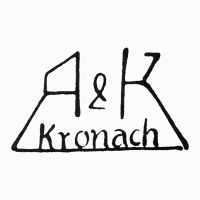
Image 010213-01/02-01
Used between 1922 and 1930, a simple "A&K" above "Kronach".
In 1872 August Alboth established a small china-refining and decorating business in the town of Coburg; its first documented mentioning was dated May 8th 1873. His son Ernst (*1868) later joined the business. After his father retired in 1899 Ernst decided to move the company from Coburg to a newly built factory in Kronach and the first few years of the new factory could still be enjoyed by August, who regulary visited the factory until he died in 1908. Ernst Alboth himself had two children: son Willy (who later joined his father in the company management in 1925) and daughter Erna. She married the Munich banker Georg Kaiser (born 1895) in 1922 and he joined Ernst Alboth as manager. In 1923 Erna then gave birth to their son, Hubertus Kaiser. After the death of Ernst Alboth in 1927, Willy Alboth (who had no children of his own) and Georg Kaiser decided to change the company name to "AL-KA", a combination of the first two letters of each family name.
Over the next few years the factory successfully established its name in the market by not only producing an extensive series of giftware but also manufacturing a high-quality series of Rococo style lace figurines which was usually a domain of the Thuringian companies. Slowly expanding, the company in 1938 acquired the Gebrüder Silbermann porcelain factory located in the small town of Hausen (near Lichtenfels, later a suburb of Staffelstein), which from then on served as main supplier for unmarked blanks used by the refining facility in Kronach. In 1945, Hubertus Kaiser became partner of the company and in order to cope with new requirements after the war and the increased demand, first plans were made to build a new factory which would include both production and decoration sections. To achieve this, the company structure had to be changed so that partners could be won without allowing them too much influence.
After the required changes had been made, the company was lead by a board of the three managers: Georg Kaiser, Willy Alboth and Hubertus Kaiser. Further investors were quickly found and in 1953, new premises in the nearby city of Staffelstein were acquired in order to build the new factory there. Staffelstein was the perfect location as it was very close to the Hausen factory which would continue production until the new factory was completely finished and on the other hand it was close enough to the town of Kronach and its skilled workers. The move however would still take a while as the company had to apply for a building permission and get through the general planning stages first, and then the new factory still had to be built and thoroughly tested.
But overall production capacity had already reached its limit, forcing the managers to find some sort of interim solution. Early in 1955, Alboth & Kaiser therefore took over another company also located in Kronach, the Porzellanfabrik Oechsler & Andechser, a business which itself had only been established in 1950. Not only was its location ideal for the cause, the whole equipment was also in top shape; hence it was fully integrated into the Alboth & Kaiser work process in under two weeks and greatly improved the production capacity situation until the whole company was finally ready to move to its new location.
The move itself came with many changes for the company and the factory in Hausen was finally abandoned, selling it to the Porzellanfabrik Schauberg Richard S. Rösler in Schauberg (Bavaria). After making sure that the company made a good start at the new location, Georg Kaiser decided to slowly retire, leaving the company in the hands of Willy Alboth and Hubertus Kaiser from 1961 onwards. By the time Georg Kaiser died in 1964, Willy Alboth's son Ernst had just joined the company.
Shortly before 1970 the general direction of the company was re-focussed and a more export-related business was taken in mind, therefore it was decided to change the company name and alter the trademark to a simple Kaiser-Porzellan because the name was more melodious, which of course would play an important role in foreign countries. During this period a lot of figurines based on designs by Giuseppe Cappé and Karl Tutter were produced and many designs for tableware were based on the work of people like K. Nossek. At the end of 1977 Ernst Alboth became manager, leading the company into a new and successful decade together with his father and Hubertus Kaiser.
In 1982 Kaiser-Porzellan could really claim to have become a worldwide trade name and especially among collectors as well as china-lovers the selected animal sculptures had become extremely desired. The 200th anniversary of the United States of America therefore saw the creation of a model of the U.S. national emblem and national bird - the bald eagle - in a strictly limited edition of 200 pieces, modelled in its natural size by the well-known Italian sculptor, Professor Guiseppe Tagliariol. The first finished piece, #001, was presented to U.S. President Ronald Reagan on October 5th 1982 by Hubertus Kaiser, who also presented #047 to the former British Prime Minister Margaret Thatcher on June 13th 1984.
Based on the ongoing increase of sales, a new factory building with over 7,000 square meters was built on the premises during 1985 which was followed by a state-of-the-art fast-firing-oven in 1986. Just as the company reached its maximum turnover of DM 51 million, Willy Alboth died in 1991. His grandchild Hubertus Alboth stepped into the company, but the young manager already saw the German porcelain market crumbling: after German reunification, many former state-owned East German factories were re-privatized via the Treuhandanstalt, giving them a secure financial background which many West German companies - already trying to hold up against imports from Asia and other Eastern countries - could not hope for.
Hubertus Kaiser on the other hand tried to remain optimistic, and in 1997 the completely family-owned business proudly celebrated its 125th anniversary. By then, annual turnover had steadily decreased to a mere DM 35 million and the management had already discussed all kinds of plans to save the company. But the battle was hopeless and eventually pushed Hubertus Kaiser to the brink of exhaustion, leading to his untimely dead on December 17th 1998.
It remained up to Hubertus and Ernst Alboth to decide what would happen with the company itself and the just over 500 remaining employees. In a last attempt to save the company, the assortment was completely restructured to 50% tableware, 40% gifts and 10% figurines, which in turn allowed to lay off 100 employees as part of a social plan in 1999. Annual turnover decreased to DM 26 million and so the overall workforce was reduced to 350 people early in the year 2000, however it was obvious that turnover would decrease more and more due to the general crisis in the German ceramics industry.
On October 27th 2000, managing director Hubertus Alboth requested initialisation of the insolvency procedures at the district court of Coburg. Even if it had been known for some time that business had been well behind expectations, the news came as a shock for the locals. On November 14th 2000, the Bavarian Minister of Economics, Mr. Otto Wiesheu, could only refer to the meetings which had taken place on October 5th and October 25th, trying to find a solution to at least save a large part of the jobs.
The morning of December 28th 2000 saw the company being taken over by two investors out of the ceramics industry, the Pacific Crown Group Ltd. and Hans-Peter Langsch. At that time a mere 130 workers were still employed and the last turnover obtained was about DM 23 million. But the takeover indicated a vital turning point and the provisional committee of creditors agreed to purchase only a day later, allowing Hans-Peter Langsch to take over management of the thus newly created Kaiser-Porzellan Manufaktur Staffelstein GmbH & Co. KG on January 1st 2001.
And so the complete factory including the area with about 65,000 square meters came under management by the PM Kapital GmbH & Co. KG, complementarily with the PM Verwaltungs-& Beteiligungs GmbH (which also runs the factory outlet). The first months started out very promising and in May 2001 the workforce had already increased to 154 workers which partly even worked overtime. The month of July saw the conventional continuous firing kiln being replaced by a discontinuous firing chamber-kiln, an estimated investment of around DM 2 million. During the year 2002, the international political crisis and the substitution of the European currency lead to excessive structural changes in the entire ceramic industry, together with a drastic decline of the traditional product categories which were the prominent area of business of Kaiser-Porzellan.
After a good start into 2003 and an excellent response to the established changes in the collection, the Iraq crisis and the still changing European markets lead to a further decline of demand in late spring, which made additional restructuring of the company necessary. On May 20th 2003, a new managing company, the Porzellan Design Bad Staffelstein GmbH & Co. KG, took over the operational activities. Successfully, size and internal organization of the company were once again adjusted to the change of demand and the complete collection was restructured and geared to target new audiences by 2007.
Next to Kaiser-Porzellanmanufaktur Staffelstein, the PM Kapital GmbH & Co. KG on September 1st 2010 also took over Goebel Porzellan, former (and later re-instated) creator of the famous M.J. Hummel figures.
The town of Kronach is very old, first mentioned in 1003 A.D. as Urbs Crana, hence many local companies directly use (or at least refer to) the historic name of Crana. Alboth & Kaiser produced one complete series of marks which included the name Crana in the crown. Following their impressed "GK" mark, the Gebrüder Kühnlenz also used an impressed "K" encircled by a "C", representing "Kühnlenz in Crana", and Oechsler & Andechser used the initials "OCA", representing "Oechsler (Crana) Andechser" to show where their business was centered. These snippets of information are often lost over time, creating unnecessary puzzles for later generations of collectors.
Next to the common marks shown, Kaiser also registered a few design names, including the series Maxima and Schloßgarten. Another series (please see Berlin Design) included Christmas and Mothers Day themed plates. Some Kaiser items carry the artist signature M. Frey which belonged to the designer and artist Manfred Frey.

Image 010213-01/02-01
Used between 1922 and 1930, a simple "A&K" above "Kronach".
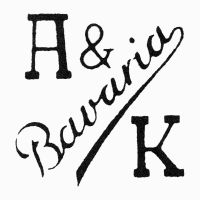
Image 010213-01/02-02
Used between 1922 and 1935, initials "A&K" separated by "Bavaria".
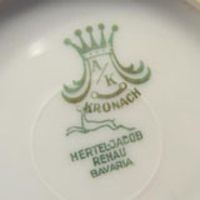
Image 010213-01/02-03
Used between 1926 and 1935 on (re)decorated items, here on an item by Hertel, Jacob & Co. (original mark used between 1930 and 1967).
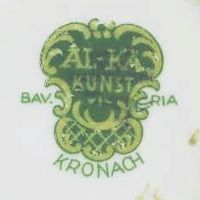
Image 010213-02-01
Used between 1935 and 1951 on (re)decorated iems, a green and yellow cover-up mark.
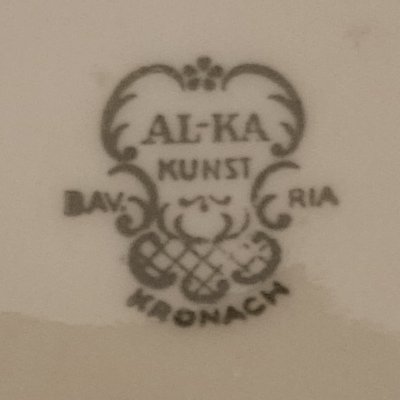
Image 010213-02-02
Used between 1935 and 1951.
(Picture: Rodolfo Jesús Burdisso)
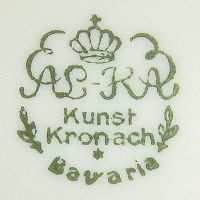
Image 010213-02/03-01
Used between 1947 and 1956, here an example in green.
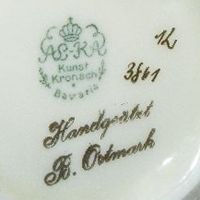
Image 010213-02/03-02
Used between 1947 and 1956, here an example in green, with B. Ostmark addition.
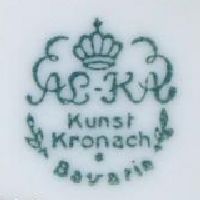
Image 010213-02/03-03
Used between 1947 and 1956, here an example in blue.
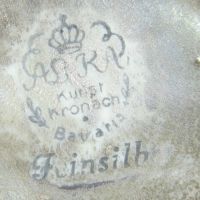
Image 010213-02/03-04
Used between 1947 and 1956, here a grey example with "Feinsilber" addition on an item decorated with silver overlay.
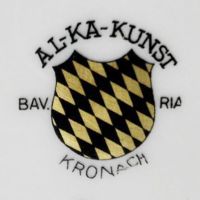
Image 010213-02/03-05
Used between 1948 and 1956, here in black and gold. Most versions of this mark type used "Bav." and "ria".
(Picture: Kate Potter)
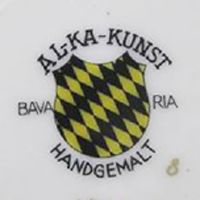
Image 010213-02/03-06
Used between 1948 and 1956, here in black and yellow. This example shows 'Bava' on the left and 'ria' on the right.
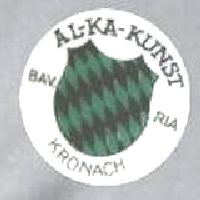
Image 010213-02/03-07
Used between 1948 and 1956, here a rare version in black and green.
(Picture: Fran Kerbs)
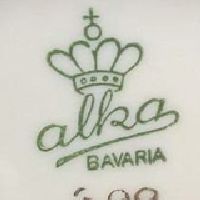
Image 010213-02/03-08
Used between 1938 and 1956, "Alka, Bavaria" in green.
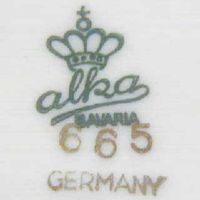
Image 010213-02/03-09
Used between 1938 and 1956, "Alka, Bavaria" in green with golden "Germany" addition.
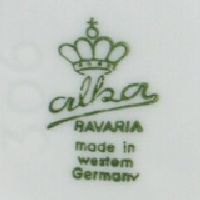
Image 010213-02/03-10
Used between 1949 and 1956. "Alka, Bavaria", with green "Made in Western Germany".
(Picture: Ivan Golsky)
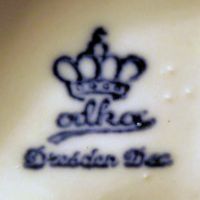
Image 010213-02/03-11
Used between 1938 and 1956, "Dresden Dec." without addition.
(Picture: Fran Kerbs)
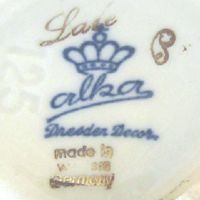
Image 010213-02/03-12
Used between 1949 and 1956, "Dresden Decor." here with golden "Made in Western Germany" addition.
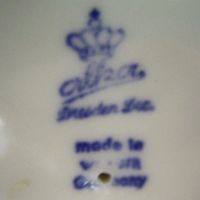
Image 010213-02/03-13
Used between 1949 and 1956, "Dresden Dec." here with the included "Made in Western Germany" in blue.
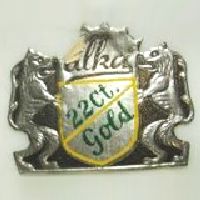
Image 010213-02/03-14
Used for some time before 1956, silver-based sticker stating "22 Ct. Gold".
(Picture: Fran Kerbs)
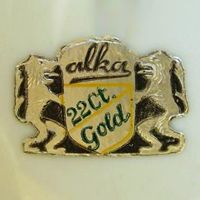
Image 010213-02/03-15
Used for some time before 1956, gold-based sticker stating "22 Ct. Gold".
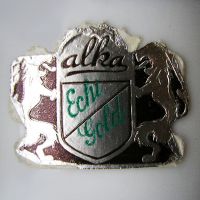
Image 010213-02/03-16
Used for some time before 1956, silver-based sticker stating "Echt Gold".
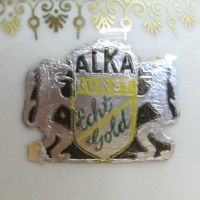
Image 010213-02/03-17
Used for some time before 1956, silver-based sticker stating "Echt Gold" and different "ALKA" typeface.
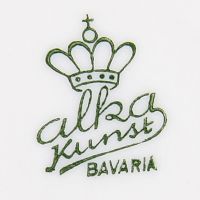
Image 010213-04-01
Used between 1956 and 1960, "ALKA Kunst, Bavaria" here in gold.
(Picture: Kelly Lockard)
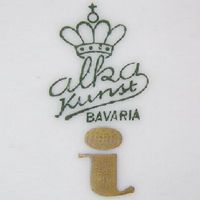
Image 010213-04-02
Used between 1956 and 1960, "ALKA Kunst, Bavaria", here with an additional mark as this was made for a decoration store.
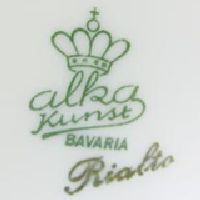
Image 010213-04-03
Used between 1956 and 1960. "ALKA Kunst, Bavaria" in green on a "Rialto" set.
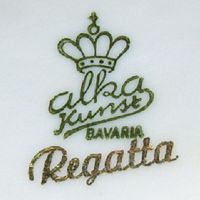
Image 010213-04-04
Used between 1956 and 1960. "ALKA Kunst, Bavaria" in green on a "Regatta" set.
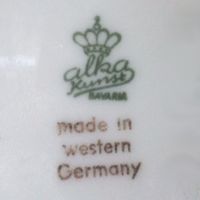
Image 010213-04-05
Used between 1956 and 1960. "ALKA Kunst, Bavaria", with golden "Made in Western Germany".
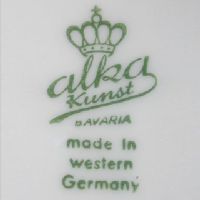
Image 010213-04-06
Used between 1956 and 1960. "ALKA Kunst, Bavaria" in green here with "Made in Western Germany".
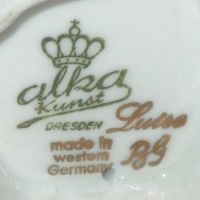
Image 010213-04-07
Used between 1956 and 1960. "ALKA Kunst" above (style indicator) "Dresden", here with golden "Made in Western Germany".
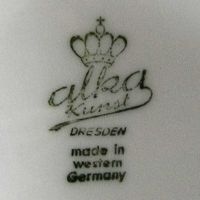
Image 010213-04-08
Used between 1956 and 1960. "ALKA Kunst" above (style indicator) "Dresden", here with green "Made in Western Germany".
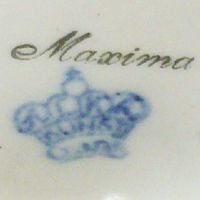
Image 010213-04-09
Used around 1956. "ALKA Kunst", product line "Crana", series "Maxima".
(Picture: eBay user tradersuz)
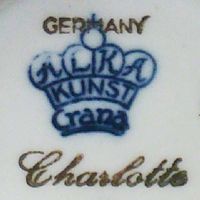
Image 010213-04-10
Used around 1956. "ALKA Kunst", product line "Crana", series "Charlotte", with "Germany".
(Picture: eBay user tradersuz)
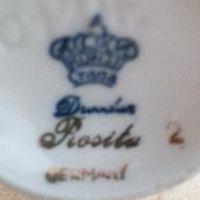
Image 010213-04-11
Used around 1956. "ALKA Kunst", product line "Crana", series "Rosita", with "Germany" and "Dresden".
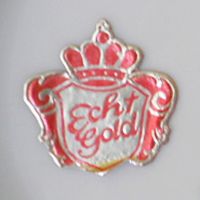
Image 010213-04-12
Used for some time after 1956, without company name, earlier version of this sticker.
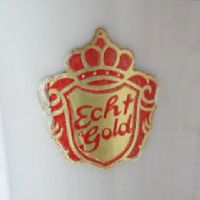
Image 010213-04-13
Used for some time after 1956, without company name, later version of this sticker.
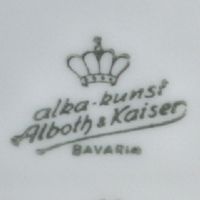
Image 010213-04-14
Used between 1958 and 1960, "ALKA-Kunst" and "Alboth & Kaiser" above "Bavaria".
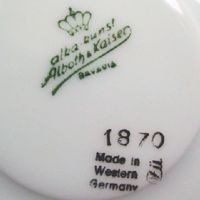
Image 010213-04-15
Used between 1958 and 1960, another example but this time with "Made in Western Germany" addition.
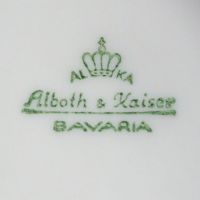
Image 010213-04-16
Used between 1960 and 1967, here the regular green example.
(Picture: Fran Kerbs)
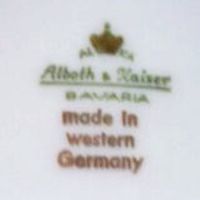
Image 010213-04-17
Used between 1960 and 1967, here a green/yellow combination with golden "Made in Western Germany" addition.
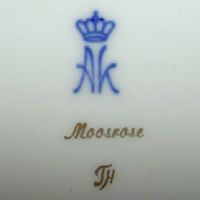
Image 010213-04-18
Used between 1967 and 1970, simple crowned "AK".
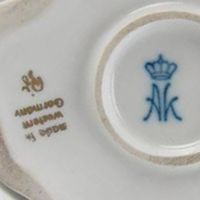
Image 010213-04-19
Used between 1967 and 1970, with "Made in Western Germany" addition.
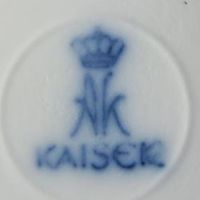
Image 010213-05-01
Used between 1970 and 2001, without country of origin. This mark may also include the ® mark.
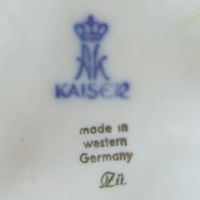
Image 010213-05-02
Used between 1970 and 1979, here with "Made in Western Germany" addition.
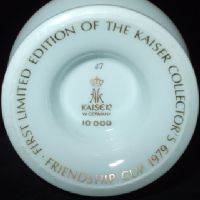
Image 010213-05-03
Introduced 1979 for use on limited editions, here on the first Collector's Friendship Cup.
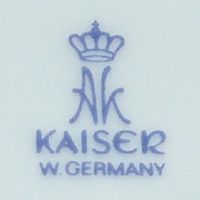
Image 010213-05-04
Used between 1979 and 1990, note the "W. Germany".
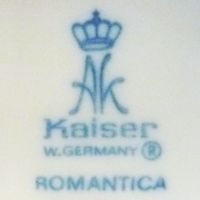
Image 010213-05-05
Used between 1979 and 1990. Also includes the "W. Germany" but also contains a ® mark.
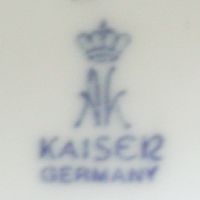
Image 010213-05-06
Used between 1990 and 2001, crowned "AK" above simple "Germany".
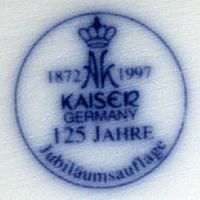
Image 010213-06-01
All-blue anniversary mark used 1997, states "Germany" and "Jubiläumsauflage" ("anniversary edition").
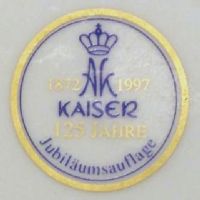
Image 010213-06-02
Blue and gold anniversary mark used 1997, also with "Jubiläumsauflage" but without "Germany".
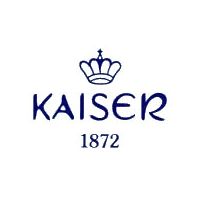
Image 010213-06-03
Company logo used since 2001.
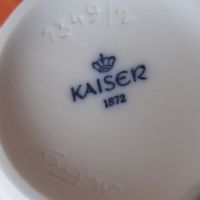
Image 010213-06-04
Base mark used since 2001 (here on an item designed by Manfred Frey).
© 2004-2025 C.S.Marshall, all rights reserved